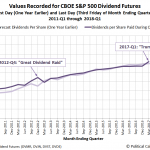The behavior of the fixed income market is different this week from recent weeks. This is because a few hawkish comments from some Fed officials completely ruled out the dovish mood felt after the Fed announced no rate hike in its latest meeting and cut the number of projected rate hikes for this year (read: Buy Ranked Dividend Growth ETFs in Focus after Fed Meeting).
In any case, the recent data points corroborated sturdy U.S. economic growth. Plus, comments from Atlanta Fed president Dennis Lockhart, San Francisco Fed president John Williams and Richmond Fed president Jeffrey Lacker once again stirred up the rate hike talks, going by Reuters.
As per these officials, the reduced rate hike projection mainly reflected the tantrums thrown by the global financial market, which are now showing signs of cooling off.The two important indicators to measure the timing of another rate hike – labor market and inflation – are both stabilizing. San Francisco Fed president even said that he would promote a hike as early as April.
Against this backdrop, speculation of a sooner-than-expected hike in the Fed interest rates is rife again. As a result, U.S. treasury yields recorded the biggest single-day rise in over a week on March 21, 2016. On March 21, yields on 10-year Treasury notes jumped 4 bps to 1.92% while yields on two-year Treasury notes rose 3 bps to 0.87%.
Investors should note that fixed-income investing has enjoyed a great show so far in 2016, especially in the longer part of the yield curve, as risk-off trade sentiments have brightened the appeal for safer assets. However, the prospect of rising rates and risks to capital gains of the bond holdings have left investors jittery about the safety of their portfolio.
Given the situation, many investors may pull their money out of the bond market. At a time like this, investments in U.S. bonds with significant protection from potential rising rates can be good bets. Some opportunistic investors could capitalize on this backdrop in the form of inverse ETFs too.
Market Vectors Treasury-Hedged High Yield Bond ETF (THHY)
The fund seeks to replicate the price and yield performance of the Market Vectors U.S. Treasury-Hedged High Yield Bond Index. THHY has a weighted average maturity of 9.83 years while its effective duration is at negative 0.50 years. The product is high yield in nature as evident from its 30-day SEC yield of 6.04% (as of March 21, 2016). THHY charges 0.50% of expense ratio. The fund added about 5.5% in the last one month (as of March 21, 2016) (see all the junk bond ETFs here).
ProShares High Yield Interest Rate Hedged ETF (HYHG)
HYHG is another ETF which has an interest rate hedge built into its strategy as it takes a duration-matched short position in U.S. Treasury futures. Like HYGH, it also has a pretty high yield (and a modest expense ratio of just 50 basis points) of 8.77% in 30 Day SEC terms (as of February 29, 2016), indicating that this could be a safer bond and yield play for investors anxious about rising rates. This $85.1 million ETF was up 8.1% in the last one–month frame (as of March 21, 2016).














Leave A Comment